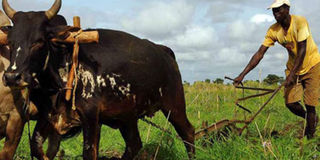Will allocations to agriculture improve household incomes?

Government has had to invest in developing agricultural development to promote sustainable productivity and increasing household income. FILE PHOTO
Kampala- The National Development Plan II identifies agriculture as a primary growth sector that will deliver Ugandans out of poverty.
Agriculture employs more than 65 per cent of Ugandans and feeds more than 80 per cent of Uganda’s industries with raw materials.
However, the continued dismal allocations to the sector is a weak link and indicates how its importance is perhaps only on paper.
In the 2018/19 budget, agriculture was allocated only Shs873b. This was a slight increase from Shs865 in the 2017/18 financial year.
Government, through the Agriculture Sector Strategic Plan, seeks to make farming a competitive, profitable and sustainable job but the allocations indicate a total mismatch.
The strategic plan also among others, seeks to create employment for youth and women as well as increase household incomes and ensure food security.
According to the 2018/19 budget out of the Shs873b allocation, Shs600b will go to development spending, accounting for more than 80 per cent.
The large allocation has left other sectors with deep cuts thereby limiting their potential and contribution to the economy.
Sectors such as crop resources, directorate of animal resources, agricultural extension and skills management, among others have suffered huge cuts and realising their potential will be determined by how frugal they are.
Budget cuts
Key sectors such as National Agricultural Advisory Services (Naads) and National Agricultural Research Organisation (Naro) have suffered budget cuts despite their contribution to advisory and research.
Therefore, one wonders how government plans to modernise agriculture yet it cannot fund research.
Government, plans to increase agricultural productivity to at least 50 per cent using research yet one wonders how this will be achieved.
In there, government also plans to use this allocation to increase agriculture exports to at least $4b per year as well as reform and strengthen agricultural service institutions, extension and regulatory bodies to make them effective and efficient.
However, on his part Mr Vincent Ssempijja, the Agriculture Minister, they will work with what is available in the hope that to make a difference.
“This time we are handling agricultural mechanisation, irrigation and improving crop yields and quality. We don’t have enough money, but that cannot stop us from moving on,” he says.
Some of the funds, Mr Ssempijj says, have been lost through donor withdrawals and the sector is only relying on government allocations.
For instance, he says, Naro only received Shs63.6b experiencing a cut of more than Shs20m due to reduced donor funding.
“Government has promised us that now it is time for infrastructure and time will come for agriculture,” he says.
In the 2019/20 financial year, he says, the agricultural sector has already planned a budget proposal of Shs1 trillion.
This, Mr Ssempijja hopes, will propel agriculture to greater heights and focus will be focused on production and productivity.
Key focus will be on increased access to critical farm inputs, improved access to markets and value addition, quality of agricultural commodities and services as well as providing an enabling environment.
The outcome of this focus, Mr Ssempijja says, will therefore contribute to the objective of increasing household incomes and promoting equity.
This, he adds, will also promote science, technology, innovation and ICT to enhance competitiveness and promote sustainable population.
However, this, he argues, will be achieved through partnerships, especially by engaging the private sector to be involved in large scale investment.
Government has already embarked on construction of valley dams in areas that experience water crisis as well as installing assorted IT equipment to pilot the e-voucher and rehabilitation of agriculture zonal research institutes infrastructure.
According to Mr Ssempijja, the construction of fertilizer stores, rehabilitation of farm access roads in the oil palm growing hubs, construction of cotton processing infrastructure and construction of coffee washers are all in progress.




